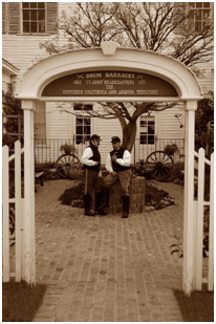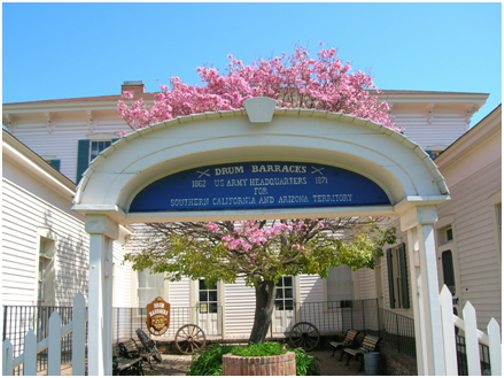|
| Drum Barracks History
The Civil War is a pivotal event in the
history of the United States. Unfortunately, few people realize
that California
played an important role in that conflict. Although the major
engagements took place in the East, troops from Drum Barracks,
kept California in the Union, protected much of the Southwest
and secured the territory which is now Arizona and New Mexico
for the Union.
The Drum Barracks Civil War Museum is housed
in the last remaining wooden building of Drum Barracks, named
after Adjutant General Richard
Coulter Drum, head of the Department of the Pacific. This
facility served as the Union Army headquarters in the Southwest
(Southern California and the Arizona Territory) from 1861 - 1871.
Drum Barracks, which was first called Camp Drum, served as the
main staging, training and supply base for military operations
in the Southwest, and occupied approximately sixty acres of land
with an additional thirty-seven acres near the harbor. The land
was sold to the Army by Phineas Banning, and B. D. Wilson, who
each received one dollar, with the agreement that the land would
revert back to them after the camp was closed.
|
 |
|
After the surrender at Appomattox, Californians
from Camp Drum continued to soldier in the Southwest during the
Indian Wars. The California units were recognized by the army
commanders of the time as being among the best equipped and trained
in the U. S. Army. Drum Barracks included the most important medical
facility in the western states. The hospital at the camp, recognized
as the best equipped and staffed medical facility west of the
Mississippi River, was so vital that the facility was kept open
for two additional years after the closure of the camp.
The structure housing the museum served
as the junior officer's quarters of the camp. In the early 1960's,
the building was due to be demolished, but through the efforts
of community groups, it was saved and opened to the public as
a museum in 1987.
|
|
 |
Lumber was ordered from New York City, shipped
around the Horn, and arrived in late 1862. Construction began
immediately and is estimated to have cost one million dollars.
The buildings were completed in September of 1863 and occupied
by their first commanding officer, Lt. Colonel James Freeman Curtis.
Many California Volunteers came through this camp and went east
to fight in the war. From 1861 to 1865 approximately 17,000 Californians
served in both volunteer regiments in the West and in regiments
fighting in the East.
Camp Drum was home to the California
Column, formed and commanded by Colonel
James Henry Carleton, first commander of the camp. In 1862,
Texas Volunteers had taken control of the territory, which is
now Arizona and New Mexico, for the Confederacy. Colonel Carleton
was ordered by the War Department to gather his troops and retake
control of the territory. Thus, 2,350 men began a march to Santa
Fe during the driest summer of the century. On the way to Santa
Fe, the California Column fought the Battle of Picacho Pass, the
westernmost battle of the Civil War. Colonel Carleton successfully
marched his large body of troops through much of the most inhospitable
territory in the United States without the loss of a single soldier,
a feat regarded as a masterpiece of military planning and execution.
|
|
|
|